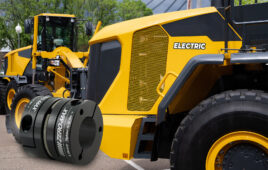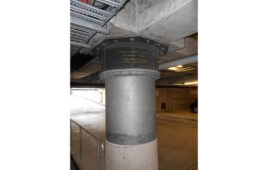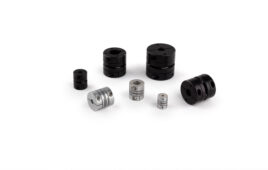 High-volume, low-speed (HVLS) fans play an important role in many applications, from agricultural processing to warehousing. These ceiling-mounted units can move large amounts of air due to their size, which generally exceeds 7 feet in diameter. In terms of their design, these fans have a geared motor that connects to a forged hub, which includes the fan blades. The entire unit must then be fastened to the motor shaft as it hangs vertically. Should this connection fail, any personnel on the floor below could be injured — or worse.
High-volume, low-speed (HVLS) fans play an important role in many applications, from agricultural processing to warehousing. These ceiling-mounted units can move large amounts of air due to their size, which generally exceeds 7 feet in diameter. In terms of their design, these fans have a geared motor that connects to a forged hub, which includes the fan blades. The entire unit must then be fastened to the motor shaft as it hangs vertically. Should this connection fail, any personnel on the floor below could be injured — or worse.
You might not think about the components that can make or break such a critical connection in HVLS applications. These heavy-duty machines require shaft-hub connections that can transmit high torques, as well as axial, radial, and bending loads, with the utmost safety and reliability.
Let’s explore how our Locking Assemblies are the right devices for the job.
HVLS Fan Functioning Principle and Advantages
HVLS are predominantly found in the agricultural and food industries to control temperatures and prevent perishables from spoiling. They also boost employee comfort on shop floors and in warehouses, and they can dissipate condensation and humidity in manufacturing environments to reduce the rate of rusting on metal machines and parts.
At slow speeds, HVLS fans produce a column of air that moves downward vertically. This air column then moves sideways and turns upward as soon as it meets a sidewall. HVLS fans work on the principle of destratification, or the process of mixing air to evenly distribute heat. Destratifying a room brings the heat down to the level of the floor, keeping people comfortable and reducing ceiling temperatures, which in turn minimizes the loss of energy through the roof and saves energy costs.
HVLS fans work efficiently no matter the season — whether summer or winter. By mixing the warm air at the ceiling with cool air at the floor level, these machines even out the temperature in a given space. This capability eliminates the need to install large, costly cooling systems in the summer and heating systems in the winter. In addition to reducing energy costs, these fans can help manufacturers meet their energy efficiency goals, reduce greenhouse gas emissions and minimize their carbon footprint.
Fan Construction and Requirements
HVLS fans have a large structure that includes a mounting system on the top to enable ceiling mounting, as well as the main drive — which is the heart of the fan system. The geared motor connects to a forged hub, which incorporates the blades along its periphery. The resulting heavy-duty unit is then fastened to the motor shaft — a connection that requires the utmost reliability. Compared to horizontal connections, the heavy fan assembly, which consists of the hub and blades, relies on this connection as the unit hangs vertically. A connection failure would not only be costly in terms of materials, but it would injure people on the floor below.
Locking Assemblies Boost Connection Reliability
Although keyed shaft connections are common in HVLS applications, demands for greater reliability and safer torque transmission due to the heavy air columns are increasing. Our Locking Assemblies are beginning to replace the keyed connections in these applications due to their reliable approach to torque transmission. These components feature a pair of double-tapered thrust rings that expand radially when tightened, creating a compression fit between the shaft and its mating component and locking the two together. And, unlike keyways, which concentrate stresses along a single line of contact, our Locking Assemblies distribute stresses evenly over 360 degrees of contact. This uniform stress distribution eliminates the wear and maintenance costs associated with keyways to deliver a highly reliable connection.
We manufacture our Locking Assemblies, which enable friction-locked shaft-hub connections, to the highest quality standards. Units are quick and easy to assemble, they offer complete freedom from maintenance and wear, and they provide backlash-free power transmission in HVLS fan applications. Thanks to these features, they’re suitable for all hubs — whether toothed gears, running wheels, chain sprockets, levers, cam discs, belt and brake discs, slip-on gears, couplings, shafts or axles.
Thanks to their friction-fit press connection, our Locking Assemblies can withstand the highest torques, and they transmit axial, radial, and bending loads safely and reliably. Our keyless Locking Assemblies are therefore a superior alternative to conventional shrink-fits, wedge, keyway, and polygonal connections, and they offer outstanding concentricity and resistance to alternating torsion. Units are available in many standard designs and sizes. We’re also happy to design you a custom solution depending on your needs.
Ringfeder
technical-content.com/blogs/ringfeder/
Filed Under: Coupling Tips




